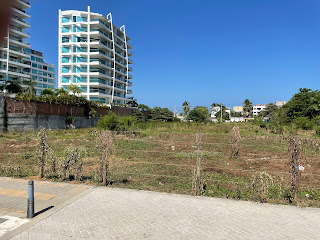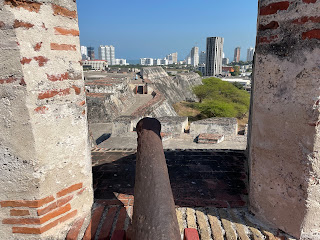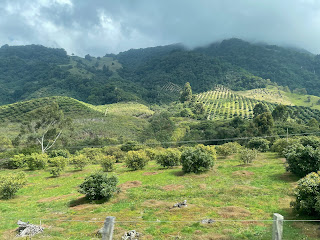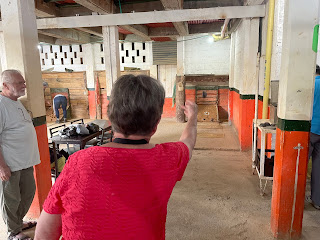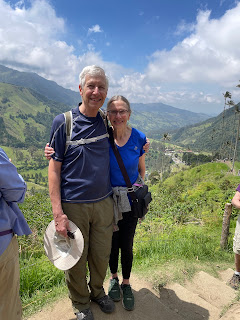First stop was inside the old city walls, in the neighborhood of "Getsemaní" (Spanish for the Garden of Gethsemane in the New Testament). This was a very low class neighborhood, known for poverty, drugs, prostitution, and violence during the period of civil unrest and drug cartels.
Now that peace and tourism are coming back to Colombia, these old, Colonial homes are selling for huge prices and are being restored as hotels and other attractions. This gentrification of the neighborhood is a two edged sword. On the one hand, the neighborhood is now safe, much cleaner, and getting fixed up with colorful murals and other decor.
On the other hand, property values are now high that poor residents can't afford to keep living in their own homes. Renovation costs and taxes are running them out.
As an exercise, our local guide, Vicki, took us into an old traditional tienda (we'd probably call it a convenience store or old-time neighborhood grocery) and gave us a set amount of money to buy lunch for a family of four. Even limiting the menu to rice and plantains, plus a couple of eggs, we went over budget.
In a very narrow street we encountered an old fruit seller, pushing his cart. Vicki stopped him for an interview in Spanish, and provided translation for us. He's been selling fruit, six days a week, in this neighborhood for 57 years. He makes a pretty good living, but there's no retirement plan, so he'll probably have to keep doing it until death.
Getsemani is becoming something of an art community. Several artists have galleries here, with art displays spilling out into the streets.
Our walk ended in a very nice park, where another man was making a living by locating all of the animals living in the park, and then pointing them out to tour guides and/or to people who wanted to feed them. Today he had found three small monkeys and a couple of sloths.
From the park we boarded a "chicken bus." These are trucks with benches bolted to their beds, usually with some sort of roof overhead. We saw them all over Central America a few years ago, being used as public transportation.
Here, they are no longer used for that purpose, but rent out as party buses. Three old guys were on board our bus as our party band, and Vicki was singing along. At one stoplight, a woman began dancing to the music beside the bus as she was waiting to cross the street. Some people waved and smiled. Most just looked at us like we were idiot tourists. If the shoe fits....
The party went on for a while, as we were transported out of the city toward the town known as La Boquella (lah boy-KAY-jah). When slavery was ended in Colombia (it happened gradually from the 1850s to the 1880s), former slaves were given marshland along the seashore that no one else wanted. Here they created a town, which now has more than 18,000 residents, almost all of African descent.
The first residents made their living primarily from fishing, but now many commute to work in the city. There is a stark contrast between the modern high rise apartments and tourist hotels that stand adjacent to the shacks of the descendants of enslaved people.
There is now an effort to reclaim and preserve the African cultural heritage of La Boquella. One organization doing this is Tambours de Cabildo, a center for traditional music, drumming, and dancing. Three elegant and obviously very talented dancers greeted us at the entry to a thatched roofed, dirt floor building near the beach.
Inside, we met musicians and drummers who explained their instruments, which have both indigenous and African origins. Then it was our turn. They tried to teach us both some basic drumming and the most often seen traditional dance, the Cumbia. Almost everyone in the group took part, but we were all pretty awful.
They must have thought we worked hard enough in the heat to need refreshment, so they passed out bottles or water and local beer. We took the beer, of course. Then the three real dancers, after a costume change, came out to show us all up. They were quite good.
We had a few minutes on the beach to see fishing activity and some folks enjoying a horseback ride. Then it was back onto the bus for return to the hotel. Lunch was "on our own" today, but we weren't particularly hungry.
We walked several blocks to an area that housed a craft market. It's all supposed to be genuine, Colombian-made crafts. We looked in several of the shops, but found mostly the same junk we see in all of the tourist shops.
We walked a couple more blocks to the former bullfighting ring of Cartagena. Bullfighting is no longer practiced here, but the ring has been turned into a modern, high-end shopping mall. However, the main bull ring has been preserved, and is sometimes used as a theater in the round.
Then we were put onto horse carriages for a ride to our farewell dinner. It was a very nice place, with live music, and the meal was good.
On the way back to the hotel we got to see some of the nightlife of the city. It's a hot Friday night in Cartagena! And it seems like we can hear it all in our hotel room.
Tomorrow, after a late breakfast, we head for the airport. We have a tight connection in Miami, so we hope we make it home on time.










